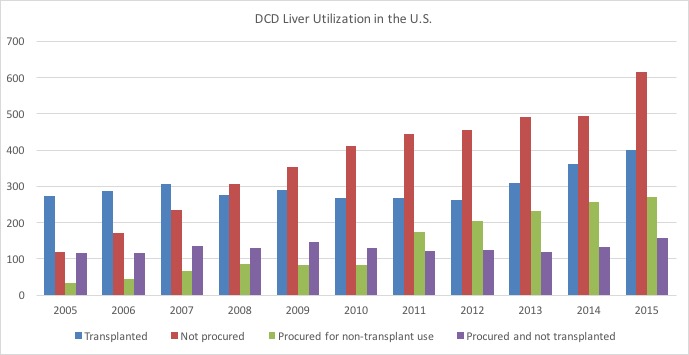National Trends in Utilization of Donation After Cardiac Death Donor Livers for Transplantation.
1Department of Surgery, Division of Transplantation, Indiana University School of Medicine, Indianapolis, IN
2Indiana Donor Network, Indianapolis, IN
Meeting: 2017 American Transplant Congress
Abstract number: C177
Keywords: Donors, Liver transplantation, non-heart-beating
Session Information
Session Name: Poster Session C: Organ Allocation, Meld Score, Organ Utilization, and Transplant Outcomes
Session Type: Poster Session
Date: Monday, May 1, 2017
Session Time: 6:00pm-7:00pm
 Presentation Time: 6:00pm-7:00pm
Presentation Time: 6:00pm-7:00pm
Location: Hall D1
Background: Optimizing utilization of donation after cardiac death (DCD) livers is imperative to address organ shortage. Understanding factors that contribute to DCD liver discards is required. We sought to examine national trends in DCD liver utilization and the relationship between donor characteristics and discards.
Methods: United Network for Organ Sharing (UNOS) standard transplant analysis and research files were reviewed. To study discards, donors ≥ 10 years old who had at least one organ transplanted were considered. A discard was defined as a liver that was procured but not transplanted or not procured at all.
Results: Between January 2005 and 2015, 10,372 DCD donors (all ages) were pursued for organ procurement. The number of DCD donors pursued increased from 541 in 2005 to 1449 in 2015. During this period, 3304 (32%) livers were transplanted, and 7060 (68%) were either discarded or not recovered. The number of DCD livers transplanted increased steadily from 272 in 2005 to 400 in 2015, and graft survival improved significantly. The number of DCD livers discarded/ not recovered has also markedly increased from 269 in 2005 to 1044 in 2015. When donors ≥ 10 years old with at least one organ transplanted were considered (n= 8635), donor age, donor BMI and history of heavy alcohol use were significant contributors to discards. Poor organ function, evaluation in the operating room, time constraints, and no recipient located were some of the common reasons for discards reported in the UNOS database.
Conclusions: Although the number of DCD donors pursued and DCD transplants performed has improved nationally, discard rates have also markedly increased. There is a huge opportunity to optimize DCD liver utilization by adopting strategies that will improve outcomes and by incentivizing DCD liver usage.
CITATION INFORMATION: Kubal S, Mangus R, Ekser B, Amos R, Fridell J. National Trends in Utilization of Donation After Cardiac Death Donor Livers for Transplantation. Am J Transplant. 2017;17 (suppl 3).
To cite this abstract in AMA style:
Kubal S, Mangus R, Ekser B, Amos R, Fridell J. National Trends in Utilization of Donation After Cardiac Death Donor Livers for Transplantation. [abstract]. Am J Transplant. 2017; 17 (suppl 3). https://atcmeetingabstracts.com/abstract/national-trends-in-utilization-of-donation-after-cardiac-death-donor-livers-for-transplantation/. Accessed December 23, 2025.« Back to 2017 American Transplant Congress
